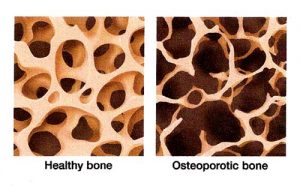 This month we are focusing on bone health. Unless you have recently sustained an injury to your bones, then it’s unlikely you’ve been putting much thought into their health. Since we can’t see our bones, it is much more difficult to remain aware and alert to their needs. For example, osteoporosis, which is a condition that degrades bones, is a common disease and yet most people aren’t aware of its serious effects on bone health.
This month we are focusing on bone health. Unless you have recently sustained an injury to your bones, then it’s unlikely you’ve been putting much thought into their health. Since we can’t see our bones, it is much more difficult to remain aware and alert to their needs. For example, osteoporosis, which is a condition that degrades bones, is a common disease and yet most people aren’t aware of its serious effects on bone health.
Effects of Osteoporosis on Bone Health
According to the National Osteoporosis Foundation, about 54 million Americans have osteoporosis. Approximately one in two women and up to one in four men age 50 and older will break a bone because of osteoporosis. The condition typically appears in women when they start menopause at age 50-55 . Male osteoporosis tends to occur after age 70. The start of osteoporosis is related to a reduction of the hormones estrogen and testosterone.
Osteoporosis is a silent disease. The first sign of the condition may only appear after a fragility fracture has already occurred. These kinds of fractures are most common in the wrist, spine, and hip. Studies show that someone who has had a fractured hip due to bone density decrease has a much higher risk of fatality because of the injury than someone else with the same fracture unrelated to osteoporosis.
Other than broken bones, osteoporosis can cause height loss or curvature of the spine. If you are experiencing either of those symptoms, it could be wise to get in contact with a healthcare professional.
Prevention
Prevention is the best form of treatment of osteoporosis. A few ways you can work to prevent the condition is by incorporating more calcium and vitamin D supplements into your diet. Some foods rich in calcium include dark leafy greens, cheese, yogurt, broccoli, and almonds. Sunlight is the vitamin D source most people know, but there are also other ways to incorporate vitamin D into your life even if you can’t get outside for lengthy periods of time. Foods such as salmon and other fatty fish, egg yolks, and portobello mushrooms are also good sources of vitamin D.
Other forms of prevention include frequent exercise, reducing caffeine and alcohol intake, as well as eliminating any smoking habits. These activities not only help prevent osteoporosis but also help to improve general bone health.
If you think you may be at risk for osteoporosis, there is also a bone density screening you can opt for. It is called a DEXA scan and is somewhat similar to an x-ray.
Treatment
There is no explicit cure for osteoporosis, however there are medications that can help reduce loss of bone density. Calcium and vitamin D supplementation can only go so far to help prevent the onset of osteoporosis, but they cannot help to reverse the effects of the condition. Only the group of FDA approved medications for treatment of osteoporosis can be used to rebuild bone mass such as: Prolia and Forteo. Only an FDA approved medication for treatment of osteoporosis can improve and rebuild the bone density and strength. Ask your healthcare provider which agent they recommend before you try to self-prescribe.

Recent Comments